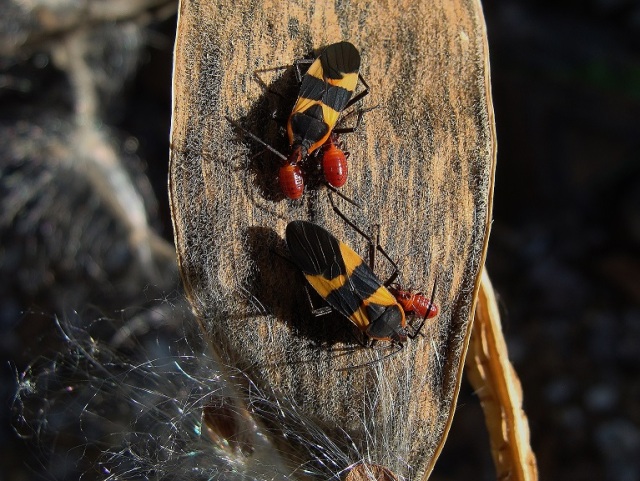Milkweeds, of the Apocyanceae (Dogbane) Family (formerly of the Asclepiadaceae [Milkweed] Family), are herbaceous perennials with 14 species identified in Arkansas. Most, but not all, milkweeds have milky sap. Milkweeds are important pollinator plants attracting butterflies, moths, ants, bees, flies, and wasps. The life cycle of Monarch butterflies depends on milkweed (Photos 1 and 2). Migratory milkweed bugs are dependent on the plant juices sucked from immature seed pods (Photo 3).
Photo 1: A travel-worn Monarch laying an egg on whorled milkweed (Asclepias verticillata)
Photo 2: Monarch butterfly caterpillar eating milkweed seedpod of butterfly weed (Asclepias tuberosa)
Photo 3: Adult and young milkweed bugs on outside of dried milkweed (Asclepias tuberosa) pod. Note seed with hairs at lower left.
Milkweeds have a unique floral structure. Milkweed flowers, arranged in round or flat clusters (umbels), do not have stamens with typical filaments and anthers or pistils with a typical stigma at top. Instead, five strongly reflexed sepals and petals surround a bizarre central structure of five anthers fused to a stigma head. To make matters more complicated, a corona (or crown) of five nectar-bearing hoods projects from the base of this structure. In most species of Asclepias (milkweed), each hood bears a curved horn (Photo 4). The horns may cause an insect to pause longer to withdraw nectar. Pollen grains are cemented into ten packets, called pollinia, located on either side of five prominent stigmatic slits. Pollinia are connected in pairs by threadlike, wiry structures to a “clip” that sits at the top of each slit. Bees and other insects occasionally lift a “spiny” foot through the slit to the clip, so that foot and clip become entangled. In removing the foot, the clip with its pair of pollinia is also removed. When the insect’s foot inadvertently slips into the slit of another flower, one of the pollina may be left behind and pollination is effected. You can try your own skill at this elaborate pollination system with a milkweed flower (the biggest one you can find) and a needle: place the needle point in the cleft of the clip at the top of a stigmatic slit and lift. The clip will come away carrying two tiny, yellow winglike packets of pollen with it–the pollinia.
Photo 4: Flowers of whorled milkweed (Asclepias verticillata) showing characteristic features of milkweeds
Seed pods enlarge from one or a few of the ovaries after the disposable parts of the flowers have fallen from the inflorescence. Pods may form a month or more after flowers have fallen and may remain on the plants for some time. Generally, few pods are formed on any one plant, but more than a hundred seeds may be in each pod. Flat, circular seed are tightly arranged in overlapping rows with white, silky, filament-like hairs (see Photo 3). When mature and dry, pods split longitudinally along a seam and seeds are tugged out by breezes and wafted aloft. Of course, those seed that provided food to the milkweed bug are not viable and seed produced in dry summers may also not be viable.
Four-leaved Milkweed
Four-Leaved Milkweed (Asclepias quadrifolia) (Photos 5, 6 and 7 ) is one of the first milkweeds to bloom in the Spring. It occurs from eastern Oklahoma and Missouri into Arkansas and in most states of the Midwest, Southeast and Northeast. In Arkansas, the species is found in the Ouachita and Ozark Mountains as well as in the highlands of the Arkansas River Valley. Habitat is dry to somewhat moist, rocky open woodlands. Plants have branched, shallow white rhizomes.
Among milkweeds, this species’ small stature is unusual. Plants are up to 2 feet tall, consisting of one or more erect, simple, smooth-looking stems with fine hairs and simple ovate to elliptic leaves. Lower portion of stem is purplish. Thin, long-pointed leaves on short petioles are opposite or alternate, but usually with one or two groups of three to four whorled leaves about mid-stem. Leaves, 1 to 5” long and ½ to 2½” wide, are entire. Sap is milky.
Flowers, approximately 15, in umbels on long, thread-like stalks may be terminal and/or lateral, so that several umbels may occur along the upper portion of the stem. Umbels typically are subtended by a pair of leaves and droop from the stem. Flowers are pink, sometimes almost white. Slender erect seed pods are about 5″ long.
Photo 5: Inflorescences of four-leaved mildweed appears with early growth
Photo 6: Flower umbels of four-leaved milkweed droop from the stem
Photo 7: Seed pods of four-leaved milkweed
Article and photographs by ANPS member Sid Vogelpohl








Pingback: Know Your Natives – Butterfly Weed | Arkansas Native Plant Society